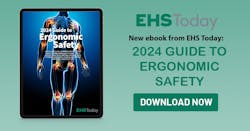2024 Guide to Ergonomic Safety
When one part of you hurts, your entire body hurts.
We all know that you can experience stiffness from sleeping wrong or sharp pains from awkwardly stepping on an uneven surface. But when the pain becomes persistent, safety professionals must act.
Recently, I've seen a growing number of workplaces disregard the source of the pain and focus instead on helping workers heal. Some workplaces have on-site clinics, footwear programs, and visiting massage and occupational therapists. These workplaces recognize that whether the reason is an old sports injury flare-up or improper bending, the result for employees is still the same: pain.
We know that pain can seep into other parts of our lives. It can make us irritable, uncomfortable and frustrated that we can no long do the things that matter to us, such as holding a child, walking the dog or working in the garden. The same is true for your work colleagues.
In many instances, the workplace is not designed for the needs of individual workers or any specifications considerations they may require. That's where ergonomics programs come into play, to bridge the gap between getting the job done and being comfortable while doing it. There are countless ways to improve workplace ergonomics, from adjusting a work surface to employing cobots to using artificial intelligence (AI) to redesigning a line.
Musculoskeletal disorders (MSDs) are often the first sign of a deeper problem. They're also often overlooked and dismissed, both by workers and by employers. It's up to safety professionals to identify the root cause, then collaborate with other departments (e.g., operations) to develop a solution that workers say improves their physical, mental and emotional well-being.
There's nothing more important than when a worker is able to do their job, go home at the end of their shift and get on with their life.
To that end, EHS Today has compiled several articles that can help you better assist your workforce. Whether you have employees working on the shop floor, in a warehouse, hybrid office setting or completely remote, we have plenty of ideas for how to make the act of work less painful.
